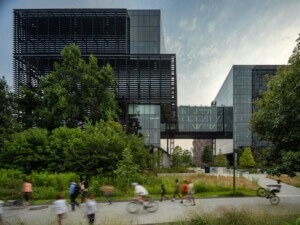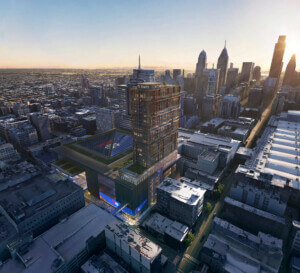This article is part of The Architect’s Newspaper’s “Passive Aggressive” feature on passive design strategies. Not to be confused with “Passivhaus” or “Passive House” certification, passive design strategies such as solar chimneys, trombe walls, solar orientation, and overhangs, rely on scheme rather than technology to respond to their environmental contexts. Today, architects are more concerned with sustainability than ever, and new takes on old passive techniques are not only responsible, but can produce architecture that expresses sustainable features through formal exuberance. We call it “passive-aggressive.” In this feature, we examine three components—diagram, envelope, and material—where designers are marrying form and performance. We also look back at the unexpected history of passive-aggressive architecture, talk with passive-aggressive architects, and check out a passive-aggressive house. More “Passive Aggressive” articles are listed at the bottom of the page!
Diagram
The promise of architecturally considered, environmentally conscious buildings that are more than exercises in technological prosthetics is taking shape around the world. Sustainable design can be achieved without subjugating space, form, experience, and aesthetics, concepts that often end up subservient to green concerns. Even offices are moving beyond the often-gauche addition of solar panels and sun shades to typical building typologies. To do so, form is playing an important role in achieving sustainability goals, and a new crop of spatially and formally exuberant projects is being realized. The result is a series of buildings that neither perform—or look—like anything we have seen before.
Perhaps the best test of a project’s sustainability aspirations is an extreme climate. Drastic temperature changes, remote locales, and inhospitable landscapes call for more than technological gadgetry to produce even a habitable project. Deserts in particular present challenges that push conventional designs to their limits. When New York firm WORKac began designing a guesthouse in southern Arizona with the goal of being completely off the grid, it looked to the southwest Earthship typology to start. Earthships are passive solar homes that use a combination of natural and upcycled materials embedded in the earth to create a thermal mass that keeps their interiors cool during the day and warm at night. WORKac took some of these concepts and elevated them into a unique architectural form. A simple diagram, the heart of the project is an adobe brick mass, upon which airy living spaces are cantilevered above the ground.
New York–based MOS Architects engaged the desert climate in its Museum of Outdoor Arts Element House. A guesthouse and visitor center for the Star Axis land art project by the artist Charles Ross, the project hovers just above the New Mexico desert on stout concrete piers. The house, designed to be off the grid, is built out of prefabricated structural insulated panels. By distilling the project down to its basic architectural components, a theme among many MOS projects, a clear yet expressive geometric system governs its overall shape. Rather than a central hearth, a series of modules each has its own solar chimney. The result is a naturally lit interior without excessive glazing to increase solar gain. A reflective aluminum shingle cladding counters even more of the sun’s intense rays while also playing visual games with the overall form. Views out of the project are captured through deeply inset operable glass walls at the ends of each module. The only typical sustainable technology visible is a solar array folly, situated just a few yards from the building.
On the other side of the world in another desert climate, Zaha Hadid Architects supersized its sustainable efforts. The King Abdullah Petroleum Studies and Research Center (KAPSARC) was founded in 2010 by its namesake as an independent, nonprofit research institution to investigate the future of energy economics and technology. KAPSARC will bring together researchers and scientists from 20 nations into one planned community in Riyadh, Saudi Arabia. Currently under construction, KAPSARC will become the main building of the campus, while formally being a campus within itself. An aggregation of six-sided plant-cell-shaped spaces, the project is a series of conditioned and unconditioned laboratories, conference rooms, lecture halls, and courtyards. Thanks to the office’s mastery of parametricism, angles, openings, and surfaces are cleverly utilized to manipulate sunlight, blocking it or allowing it into the advantage of the occupants. The modules also permit future expansion while maintaining the overall form and performance. The complex interlocking forms, and green-water-filled courtyards passively cooling surrounding spaces, echo traditional Arab courtyards buildings.
While designers strive to capture and control sunlight in the desert, in more northern climates it can be a scarce resource that is protected by code. In a city like Toronto, which averages six months of regular snowfall, new buildings can be required to allow sunlight to hit the sidewalk for portions of the day. For large projects like Bjarke Ingels Group’s (BIG) King Street development, sunlight, views, and greenspace were calculated using the latest in super-computer simulation modeling. Though the pixelated project will resemble the early diagram-driven ones from Ingels’s days with PLOT, such as the Mountain Dwelling project, King Street will be undeniably more complex. Within BIG, a smaller studio called BIG Ideas works in collaboration with Microsoft to develop predictive modeling tools for direct use by the designers. “All of the hill heights are determined by the sun and site,” Jakob Lange, BIG partner, explained. “Big Ideas created a tool for the design team to use to generate the formation of the hills. On the sidewalk, you need at least a certain amount of sunlight. The only way you can do that is to have a machine that can test every point.” The result is a seemingly haphazard stack of blocks that allow copious light and air into each unit and terrace, as well to streets and public courtyards.
Whether through high-tech computer modeling or low-tech desert vernacular, passive sustainable design is turning a corner. No longer an afterthought, environmental considerations have stopped holding projects visually captive. With improved agency, architects are striking a delicate balance between formal, spatial experience and sustainable considerations.
—Matthew Messner
Envelope
Be aggressive and show off your passive sustainability strategy facade first.
Bates Masi Architects’ Amagansett Dunes home, a modest cottage a few hundred feet from the ocean on the South Shore of Long Island, is covered on its east and west sides with operable glass. Different-sized adjustable openings create a pressure differential that promotes natural ventilation. To modulate light through these surfaces, the firm installed canvas louvers that admit cool breezes in the summer and block cold winds in the winter.
Each tapered louver is cut from one piece of canvas and wrapped around a powdered aluminum frame, its riveted strips slightly twisted to increase their transparency. The canvas pattern, which was developed through several digital and physical models, casts dappled light and dramatic shadows throughout the house and creates a lantern effect at night.
Another dramatic facade is located at Carrier Johnson + Culture’s Point Loma Nazarene University in San Diego. The concrete project has achieved LEED Gold certification through a number of sustainable solutions—from drought-resistant landscaping to smart solar orientation—and is lined with a curved, south-facing stainless-steel screen that reflects solar heat while allowing in natural light. A concrete roof overhang provides additional shading for the building and an adjacent outdoor walkway serves both as a pedestrian connector and a sort of double-layered facade. A new public plaza fronts the other side of the wall.
The wall’s staggered, water-jet-cut steel panels are unique: Each one contains a gap to allow air and views and is connected to a series of steel posts. The screen’s design makes subtle references to the religious campus, employing alpha and omega symbols, images from the cosmos, and other abstract references. “It’s both an art piece and an environmental wall,” Carrier Johnson + Culture’s design principal Ray Varela said.
Halfway around the world in Tehran, Iran, Admun Design and Construction created a memorable brick facade that shields the hot sun, encourages natural ventilation, and provides privacy while allowing limited, interesting patterns of light. Inspired by the surrounding neighborhood buildings and the city’s chaotic skyline, the facade is composed of variously rotated bricks with varied apertures. The openings change size based on the views, sun angles, and external distractions. Mortar was removed by punching the bricks, and the scheme was designed using parametric software. The process was carried out by the builders through a simple coding system. A ledge was placed in the gap between the brick membrane and the outer edge to provide space for flower boxes and to give cleaning access to the windows from outside. Balconies were placed behind the brick facade.
Indeed, low-tech solutions are becoming new again, but with a clever technological twist.
—Sam Lubell
Material
Is it possible for sustainable systems to be both high- and low-tech at the same time? That’s the question architects are answering with a resounding “Yes,” thanks to advanced, but somehow simple, passive strategies that rely on new materials. One of the most publicized solutions is New York–based raad studio’s Lowline Lab, a
heavily planted public space—still early in development—that will be located in a historic trolley terminal under the streets of Manhattan’s Lower East Side.
In order to bring natural light into the space, the team is using what they call a “remote skylight,” in which sunlight passes through a glass shield to a parabolic collector, where it’s reflected and gathered at one focal point, then transmitted onto a “solar canopy,” a reflective surface underground. The technology transmits the necessary light wavelengths to enable plants and trees to grow in the underground space. A motorized optical system (likely to be powered by photovoltaics) tracks maximum sunlight throughout the day, and the solar canopy carefully distributes light evenly throughout the space.
Raad principal James Ramsey likened the system, which uses a series of relay lenses and mirrors, to both a telescope and a plumbing system. “You’ve almost treated the light as if you’ve turned it into a liquid,” he said. “It’s only geometry. That kind of simplicity is very efficient, and there’s something elegant about that.” All these technologies, added Ramsey, are still in development, so a specific system has not been finalized. He hopes to have it nailed down in the next couple of years.
French firm studioMilou’s reimagining of the National Gallery in Singapore consists of a roof and “veil” that unite two renovated historic buildings
while creating a new courtyard. It’s another passive wonder that draws even, dappled light and keeps the buildings and their new public space cool. It mimics one of the oldest systems in the universe: a tree, with its thousands of branches stemming outward. The veil starts above the existing buildings and swoops down around them, filtering and softening natural light through thousands of laminated fritted glass and perforated aluminum panels, creating a filigree structure that also marks the new main entrance. All is supported by large aluminum columns, which effectively serve as tree trunks.
The goal, the French architects said, is for the roof and veil to resemble a handcrafted rattan tapestry. To execute the simple but complex form, the firm scanned the entire space and created a detailed 3-D model, working the roof and veil into the complex geometries of the space and even adjusting panels to fit and avoid the existing facade cornices. Each aluminum panel (chosen for its light weight and rust resistance) can be removed if maintenance is needed.
Meanwhile, Phoenix-based Wendell Burnette Architects’ (WBA) Desert Courtyard House uses a simple, reductive system to create a memorable space in a Sonoran Desert community near Phoenix while also being naturally sustainable. The house, which wraps around a courtyard containing volcanic rock, Saguaro cacti, and desert trees, is located in a low-lying area. It consists of about eight percent locally sourced cement (constituting the raised base) and 92 percent rammed earth excavated from the site. All of the extracted soil was used for the thick walls—none was taken away from the site and none was imported from elsewhere. The peripheral walls range from 3.5 to 18 inches thick, their high thermal mass keeping the home cool—although air conditioning can be used on particularly hot days. Another natural cooling system is the folded, wood-framed Cor-ten steel roof, which conducts heat up and out, creating a chimney effect.
The heavy, almost cave-like palette continues throughout the house, creating a unique aesthetic that Burnette said “feels ancient, primal, and modern at the same time.” He added, “You experience this as a shelter in a very elemental way.”
—Sam Lubell
For more “Passive Aggressive” articles, explore: Bjarke Ingels Group’s own tech-driven think tank, how WORKac’s Arizona House revives the super sustainable Earthship typology, MOS Architects’ Michael Meredith on sustainability, and our brief, unofficial history of recent passive-aggressive design.










